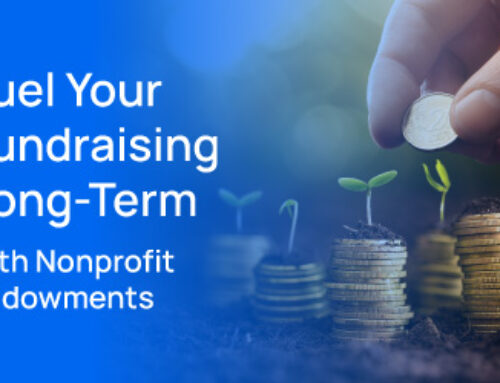As any fundraising professional is very well aware, it’s been a whirlwind of a year for the nonprofit sector. Between the COVID-19 pandemic, its ongoing economic impacts, the movement for racial justice, and the upcoming election, your team has likely had more than enough on its plate.
We can’t know what else might happen over the second half of 2020, but we do know of at least one more major event to prepare for — Giving Tuesday!
Hopefully your nonprofit is in a stable position following the tumultuous first half of the year. After making any necessary emergency fundraising appeals and doubling down on connecting with your community, it’s time to look ahead.
Thankfully, Giving Tuesday Now, an early version of the year-end event organized in May 2020 in direct response to the coronavirus pandemic, served as a perfect test run for new fundraising and engagement strategies that you were able to put together. Giving Tuesday Now raised over $503 million in online donations, so donors are clearly eager to keep supporting the causes they love amid all the disruption that’s been going on.
Giving Tuesday, coming up on December 1st this year, is a major opportunity for nonprofits of all sizes to generate additional support and reach wide new audiences. This has been true since the inception of this annual giving day, but this year’s circumstances have made it more critical more than ever for many organizations.
With several months to plan, your organization should actively prepare to tap into this ongoing surge of support to help keep your mission moving forward. Here are 5 tips we recommend to any nonprofit gearing up for a Giving Tuesday campaign in 2020 and the year-end fundraising season:
- Review your data and your unique position.
- Double check your online fundraising infrastructure.
- Create more engaging online content.
- Couple your campaign with peer-to-peer fundraising.
- Look for more ways to incentivize engagement.
These tips can help you build a stronger strategy from the start, so beginning your Giving Tuesday campaign plans as early as possible will definitely be the right move this year. Let’s dive in.
Review your data and your unique position.
 Start by reviewing your strategies and performance over the past several months. You’ve likely implemented a variety of new online fundraising, engagement, and communication tactics, so ask questions like:
Start by reviewing your strategies and performance over the past several months. You’ve likely implemented a variety of new online fundraising, engagement, and communication tactics, so ask questions like:
- What strategies have worked well?
- Have any new revenue sources opened up for your organization? Have any dwindled significantly?
- Did any new strategies end up costing more in time and resources than they returned?
- What was the impact of Giving Tuesday Now on your organization, in terms of fundraising totals, new donors acquired, or past donors retained?
If your playbook could use new strategies and tactics, now’s the time to begin exploring and preparing them. Here are some of our favorite virtual fundraising ideas to kickstart this process.
Before any major campaign or event, it’s always a good idea to take a closer look at your audience, too. Your Giving Tuesday messaging will need to be spot-on in order to compete with all of the organizations vying for your donors’ attention. Take a look at your donor data to find insights like:
- The size of the average gift given to your organization
- The social networks where followers are the most engaged with your posts
- Past campaigns or events that generated the most engagement with donors
These insights can and should help guide your strategies when promoting your Giving Tuesday campaign. But it doesn’t stop with data. Think about your donors as people. They give to your organization for a reason, so understanding what they want and why will be invaluable. This guide to understanding your donors is an excellent starting point to refresh your approach.
Additionally, take some time to reflect on the events of recent months and how they’ve affected your organization and constituents. Has your audience been uniquely affected by the pandemic? Does your mission directly relate to any public health, economic, or social justice issues that have been brought to the forefront of people’s minds?
Telling the story of how your community has been impacted and how your organization continues to make a difference should be a central part of your Giving Tuesday campaign and strategy. While you might discuss the challenges you’ve faced as an organization to motivate support from longtime donors, don’t make it all about you. Staying forward-thinking and optimistic about growing your mission will ultimately generate more support from a larger audience.
Double check your online fundraising infrastructure.
With the rapid shift to remote work and virtual donor engagement, nonprofit tech has been a big topic lately. Your organization has probably already adopted or updated one or more tech platforms to help you better stay in touch with your community from a distance.
Even if your smaller nonprofit hasn’t been able to make heavy investments in new technology, it’s still important to take the time to double check that your own toolkit is delivering as much value as it can. With the surge in traffic and donations around Giving Tuesday, you definitely don’t want technology to be a barrier.
Any nonprofit’s online fundraising infrastructure needs these essentials:
- A well-designed, functional website that works well on screens of all sizes
- A clearly-labeled and easy-to-find donation page, ideally backed up with a nonprofit-specific payment processing service
- A database, CRM platform, or another method of storing and analyzing donor and transaction data
- Social media profiles for your nonprofit on the leading platforms
- Email tools to help draft and schedule bulk emails to custom mailing lists
The shift to virtual operations has led to tons of new nonprofit trends, but you don’t necessarily need to adopt new platforms right away if those tactics aren’t central to your immediate plans. For example, free video streaming platforms like Zoom and Facebook Live are useful ways to host simple “virtual events” without needing to invest in dedicated software for the job.
However, core online fundraising and marketing tools like the ones listed above are essential. If there are any gaps in your toolkit, address them before the year-end rush approaches. Once you’ve covered your bases, there are plenty of fine-tuned improvements that can make a difference over the long-run.
For example, we recommend creating a separate donation page specifically for your Giving Tuesday campaign. This gives you a dedicated place to point donors to in your Giving Tuesday appeals, makes it easier to track campaign results, and allows you to better target the design and text of the page to match your campaign’s message. Even elements as small as the text on your donate button can have a measurable impact on performance.
Create more engaging online content.
Your nonprofit’s marketing materials will be more important than ever this Giving Tuesday. For an online-only campaign, your digital content has to do the heavy lifting in terms of reaching and engaging new audiences. These are the three most important types of content to create:
- Social media posts, including compelling photos or graphics
- Videos telling the story of your mission and your constituents
- Emails to generate buzz for your Giving Tuesday campaign and appeal for donations
For your social media posts, in particular, actively encourage plenty of shares and clicks. Create a unique hashtag for supporters to share their own stories or photos, and engage directly with your followers.
![]() One best practice for any type of online marketing is to clearly define what you want your reader to do after engaging with your message. This call to action should be clear and prominent. For your Giving Tuesday campaign, the target action will almost certainly be making a donation. Include a clearly labeled link straight to your donation page.
One best practice for any type of online marketing is to clearly define what you want your reader to do after engaging with your message. This call to action should be clear and prominent. For your Giving Tuesday campaign, the target action will almost certainly be making a donation. Include a clearly labeled link straight to your donation page.
There are also cases in which you might direct readers towards a different action, like visiting your website or signing up for emails. Determining this target action before drafting and implementing your marketing plan is extremely helpful for keeping your efforts focused.
Creating engaging, thought-out content to get new supporters in the door is definitely important, but what comes next? Let’s say a dedicated donor has shared your social media posts promoting your campaign. Their own friends see the posts and click through to learn more about your nonprofit on your website. What will keep them there?
Creating engaging content for your own website is also critical these days. Photo galleries, blog posts, and stories from constituents can help make your site more engaging for visitors and increase the chances they’ll make a donation. Just don’t forget to keep the focus on your mission and your donation page!
Couple your campaign with peer-to-peer fundraising.
Peer-to-peer fundraising has probably been on your nonprofit’s radar for a while. This social media-based, decentralized style of fundraising empowers your supporters to secure donations on your behalf. There are a few reasons why peer-to-peer fundraising is a natural fit with your Giving Tuesday campaign:
- It greatly expands your audience. Increasing your visibility on social media will be essential for Giving Tuesday success, and it gives you a strong base of new contacts to begin building relationships with over time.
- It taps into the power of social proof. When an individual sees that their friend or loved one actively supports your cause enough to fundraise for it, they’re much more likely to get involved themselves than if your organization reached out on its own.
- It generates more donations. In a well-planned peer-to-peer campaign, a larger audience combined with the power of social proof will ultimately generate more donations than you’d receive in a centralized campaign style.
- It strengthens relationships with your fundraisers. By empowering or actively recruiting volunteers to raise donations on your behalf, you let your fundraisers engage much more directly and impactfully with your organization than they typically might. This lays a powerful foundation for deepening those relationships and retaining their support.
For Giving Tuesday, we recommend empowering your supporters with DIY-style peer-to-peer fundraising tools. This means anyone can create their own personalized donation page and set fundraising goals when promoting your organization online. Top donation software should be able to offer peer-to-peer features like these. Just be sure to promote these options well in advance of Giving Tuesday itself!
Peer-to-peer fundraising is an effective way to boost your entire Giving Tuesday strategy, especially when you take a proactive approach to engaging with followers and amplifying their voices. Plus, it can open a new ongoing revenue stream for your nonprofit, helping you avoid the common fundraising mistake of relying too heavily on just one source or event.
Look for more ways to incentivize engagement.
With strong marketing tactics, many organizations successfully reach wide new audiences on Giving Tuesday, raising much-needed year-end support in the process. However, you need concrete strategies in place for retaining those new supporters, too.
The best way to begin building long-term relationships with new Giving Tuesday supporters is to incentivize more engagement from the start. In your follow-up emails thanking donors for the support, consider directing them towards a new way to get involved and learn more about your nonprofit. These might include:
- Asking donors to subscribe to your email newsletter.
- Suggesting merchandise add-ons in your follow-up messages.
- Offering free tickets to a special virtual thank-you event.
- Promoting matching gift opportunities that donors may be eligible for
- Highlighting your next virtual volunteering opportunity
The main idea is to actively encourage your new Giving Tuesday supporters to take the next step. Otherwise, you can’t count on donors to remember your organization amid all the other distractions in their busy lives. By actively providing the next step, you begin the process of building a relationship with each new donor. Plus, when a donor takes the next step that you suggest, you’ll know to reach out to them again as a supporter with a proven interest in staying involved.
Definitely don’t come off as entitled to donors’ time, money, or attention. However, you should make it easy for them to remember your nonprofit and stay engaged.
After a tumultuous several months, your nonprofit might be desperate for a quick break. Not so fast! Giving Tuesday 2020 will be more important than ever for many organizations, and the best strategy for success is to get started planning your campaign early.
First, shape the outlines of your Giving Tuesday campaign with data and double check your tech infrastructure. Then, create compelling marketing content, empower supporters with peer-to-peer fundraising options, and develop a plan to encourage more engagement from new donors. These tips can help your organization plan your most successful Giving Tuesday yet as we head into the year-end season. Best of luck!
 Thanks to Ryan Ozimek of Soapbox Engage for this article.
Thanks to Ryan Ozimek of Soapbox Engage for this article.
As the founder of a software company serving the public sector, Ryan passionate about empowering organizations to “do good”. With a focus on effective and efficient technology solutions, he’s constantly looking for ways in which the Internet can better serve the greater good, and more specifically the non-profit sector. He leads up the Soapbox Engage team in our pursuit of affordable and accidental techie-friendly online engagement software, is a Salesforce MVP, and leads the NPSP Days around the world. Ryan has a bachelor’s degree in communications from UCLA, and a masters of public policy from UCLA’s School of Public Affairs. He’s also a fan of burritos, so if you have any tips to finding the best taqueria in the world, let him know.






Leave A Comment